|
We purchased the Defender in 2003 in preparation of our trip through Africa. Graham sold his Defender 90 and Connie sold her Series IIa to raise the funds for the overland machine. We spent a great deal of 2003 putting the 110 together and completing all the modifications we thought would be necessary for such a long overland trip. The list of modifications is pretty extensive and is detailed below!
An overland vehicle is, by its nature, a creature of compromise. With a high payload, a high demand on both power and fuel efficiency and a demand for ability and reliability. Our vehicle is but one example of how to balance these compromises. Most of our ideas have been stolen from others, and we have achieved, what we consider to be a very effective balance for our needs. Others will have other requirements and will solve the same issues in other ways.
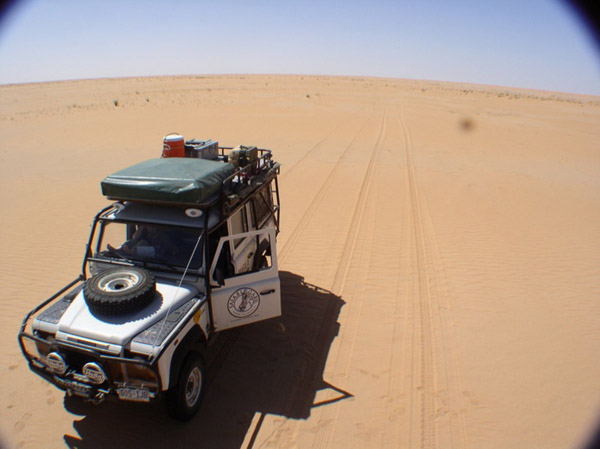
For Africa our expectation was to need to replace the air filter twice on the trip. Since 300tdi air filters are so large, it was a great space savings to use a K&N air filter instead of the stock unit. The K&N can be (and was) cleaned pretty easily and did a fine job for us.
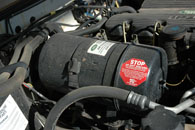
The awning from Hannibal has no supports to the ground and is, therefore, fully supported by the car. This makes it very easy and quick to set up, and also allows the car to be moved with the swning expended. It also has sides so it can become an enclosed tent.
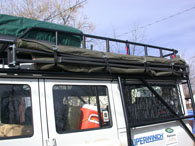
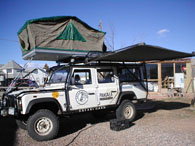
The Hellroaring dual battery system allows one battery to be used while the vehicle is stopped without allowing the vehicle battery to be discharged. When driving the batteries are both charged by the vehicle. The batteries we used were both Optimas. A Red Top for the car and a Yellow Top deep cycle for the 'house'.
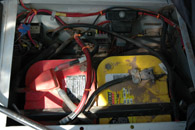
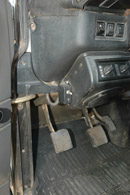
Freya donated Geoffery for beer cracking duties. He was well used in Africa, and continues to be an important modification.

Standard Safari Gard bull bar with modifications by Spidertrax for the limb risers and the roll cage connections. Includes a swivel tow point, winch and light mounts. The skid plate provides protection for the tie rod and the steering damper.
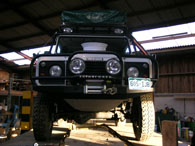
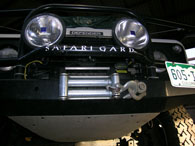
For security, the Tuffy center console was installed between the front seats. It houses the stereo, and has a large compartment for odds and ends. It also has two large cup holders.
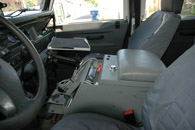
Standard Safari Gard rear corner protectors modified by Spidertrax to integrate the roll cage. Spidertrax also added a protector for the rear water tap.
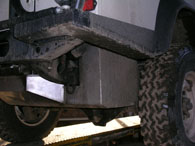

In addition to the standard bolt mounting the diff guard, we added two small beads of weld for extra security.
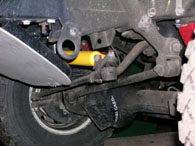
Very important to have, we mounted one by the rear door. It proved easy to get to when Graham set the campsite in Moremi on fire.
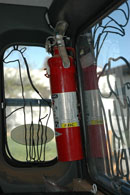
For additional floor protection we invested in Land Rover rubber floor mats.
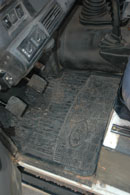
For the all-important task of keeping beer cold, the Engle was installed behind the front seats. It is attached to an Engel slidelock for quick release and is ensconced by an Engel Transit Bag for additional insulation. We also installed an indoor/outdoor thermometer on the center console to monitor the temperature of the fridge.

The Garmin GPSMap 176 was selected because it has a larger screen which makes it easy to reference when driving. So we don't rely on batteries, the GPS power is wired into the house battery. There is also a serial communication cable wired through the dash to the laptop table so that the iBook and the GPS can be attached for more navigation options. The serial connector is mounted next to the stereo in the center console. The iBook only has USB connectors, so we have a Keyspan serial to USB converter wire-tied to the laptop stand. We used a standard Garmin sticky mount that we attached to the top pf the dash. Graham, always suspicious, welded an additional nut onto the mounting plate in case the Garmin mount broke, which it did in Morocco.
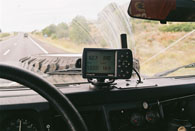

In Morocco, after stories of trucks and rocks, we decided to add headlight protection to the trucks. Witt got some steel mesh from a hardware store and we wire-tied sections of it to the bull bar. This solution lasted all through Africa, though the mesh was getting very work by the time we got to South Africa.
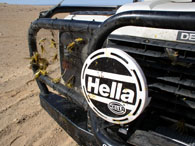
When Graham had a Defender 90 in Colorado he had got a heater cowl for the heater air intake on the wing. This provided much better heat in the car. The cowl was saved and put on the 110, despite not really needing an efficient heater in Africa.
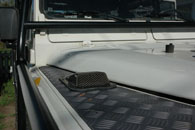
A Coleman 700 watt inverter was installed under the rear seat. It provides 115v power for the Dremel, video camera and other appliances. Given that we had one of these inverters fail on a previous trip, I built a box with additional cooling fans for this inverter. It is run off the house battery.

To allow easy access to the iBook when traveling, a laptop stand was built that attaches to the passenger seat rail. This allows use of the iBook when traveling for navigation, and can be swiveled for use by either driver or navigator.


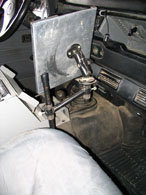
Two Hella 4000s on the bull bar provide significant driving illumination. Two Hella FF330s forward facing on the roof rack are aimed slightly to the side for cornering illumination. Two Hella FF330s on the rear of the roof rack provide backup illumination.
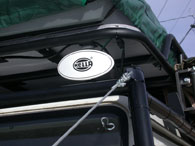
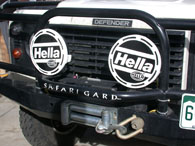
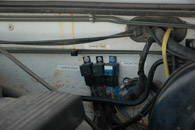
The instrument console houses four switches and two gauges and is located in the stock Defender 110 dash radio mount. The switches are for the front lights, the front roofrack lights and the rear roofrack lights. The fourth switch was intended as a master on/off for the compressor but I ran out of time and didn't wire it up. The two guages are for engine water temp and oil temp. I ran out of time and never installed the senders in the engine, so the guages don't do anything at the moment.
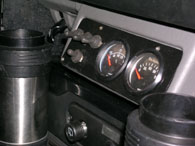
Light is a huge boon when camping. We installed a 2-bulb fluorescent light in the rear load bay and a regular interior light on each rear door pillar. In addition we carried two ARB Adventure lights for more remote lighting.
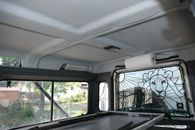

Taking advantage of the mounts that Spidertrax provided, we ran steel cable from bull bar to roll cage. This protects the windscreen from tree limbs when going through tight vegetation.

A 37 gallon stainless steel fuel tank. It allows a range of 800 miles under the most arduous conditions, but it does reduce the rear departure angle and can cause the rear of the vehicle to 'get hung'.
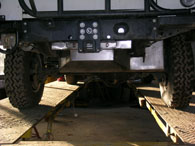

To give non-driver interfering light to the passenger we installed a map light on the dash board.
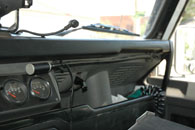
Part of our storage solution, this box mounts to the frame and houses 8 quarts of oil on the top shelf and enough space on the lower shelf for gear oil and brake fluid.
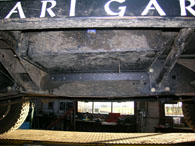

The onboard compressor is mounted under the passenger seat and is wired to the main vehicle battery. A 2.5 gallon air tank was added to the frame to allow additional capacity.
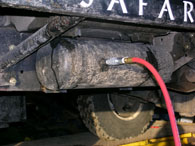
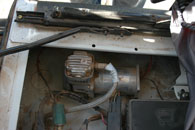
Certain things always need to be handy. Papertowels are in this category, and to keep them handy we built a mount above the rear door.

Cigarette style power points were added in several places on the truck. One by the rear door, two under the rear seat one of which is dedicated to the fridge, and one on the roof rack. All are powered off the house battery. The cigarette lighter on the dash was re-wired to the house battery and is mainly used for the laptop.

As a rear recovery point as well as for towing should the need arise, we installed the Safari Gard hitch.
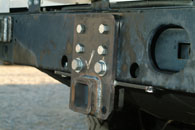
The Safari Gard Rock Gard kit protects the track rod behind the front axle.
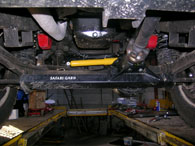
The roll cage was made by Spidertrax in Hygiene Colorado. The main purpose it to protect the occupants in an accident and to support the roof rack. It also serves as a mounting point for the rear window protection and the limb risers and provides an integral ladder for roof rack access.
The roof rack was custom made for us to attach to the roll cage and integrate the tent. It also provides mounting for the hi-lift jack, the axe, a light items box and two jerry cans.

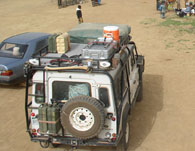
The Technitop tent is mounted forward on the roof rack and opens over the hood of the vehicle. The front ladder drops to the bull bar.

In dirty environments it is much easier to clean seat covers than seats. We installed genuine Land Rover waterproof seat covers, and they have lasted very well.
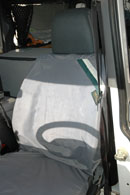
Standard Safari Gard sliders modified by Spidertrax to interface with the roll cage. Spidertrax also added additional braces from the sliders to the frame.
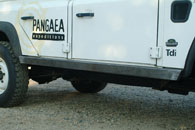
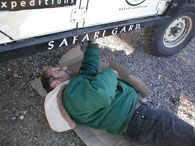
The OME steering damper was installed to take the African abuse to the steering system.

We chose a CD player that would play MP3 CDs. For the Africa trip we put together MP3 CDs of our favorite music. We used the stock Land Rover front speakers, but added two larger speakers on the front of the side storage boxes.

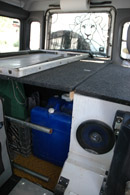
A heavy duty filing cabinet became a 4 drawer rear storage system under Connie's direction. She also built side boxes that run on either side of the drawers. In front of the drawers is a fairly large area that we used for water carboys and items we didn't have to access very often.
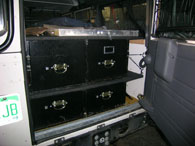

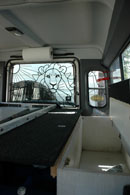
The JEK Stage II suspension from Safari Gard was comprised of Fox 10" emulsion shocks, custom SG front progressive springs and Old Man Emu heavy duty rear springs. It was both a blessing and a curse in Africa. See Iteration 2.

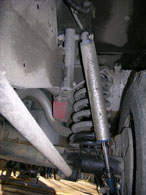
To make carrying a camp table as efficient as possible, we built our own table. It has folding legs and mounts to the top of the rear storage area to keep it secure. In addition the table can be placed over the fridge to allow enough flat surface in the rear to sleep on should we need to abandon the tent for any reason.

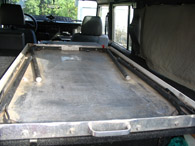
Keeping small items handy is always a chore. Connie built brilliant mounts for tire guages on each windscreen pillar. It keeps them very handy and secure.
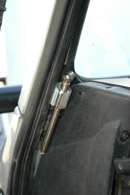
Standard Safari Gard Defender 90 soft top tire rack allows spare tire mount and space for 2 jerry cans. We modified the hi-lift jack mount for use with a shovel.
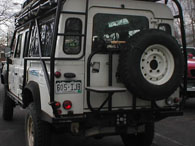
This is a 7 US gallon drink cooler from Home Depot. We mounted it to the roof rack. Just put clothes, water and detergent in, and while driving, the agitation gets the clothes clean. The rougher the road the better!!

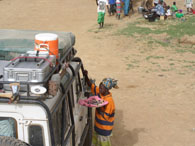
This is a 7 US gallon stainless steel water tank mounted in the rear left-side wing. The tap is mounted to the rear cross member.
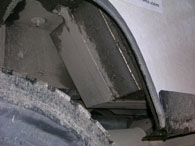

Superwinch donated an X9 9,000lb winch to our Africa cause. The winch is run from the main vehicle battery, an Optima Red Top. The winch controller plug was relocated to the top of the drivers side wing.
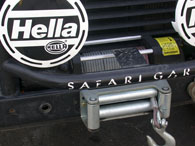
The window protection over the rear load bay windows was custom designed and built by Connie's parents Sue and Alpine. Scenes depict a lion in the rear main window, giraffes in either rear small window, elephants on one side and zebras on the other.
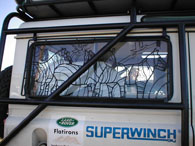
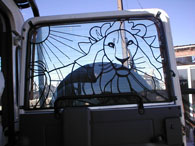
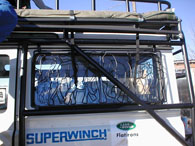
The Defender wings are aluminium, and are pretty maleable. To add some peace of mind when clambering on the car we added genuine Land Rover wing-top diamond plate protection.
|